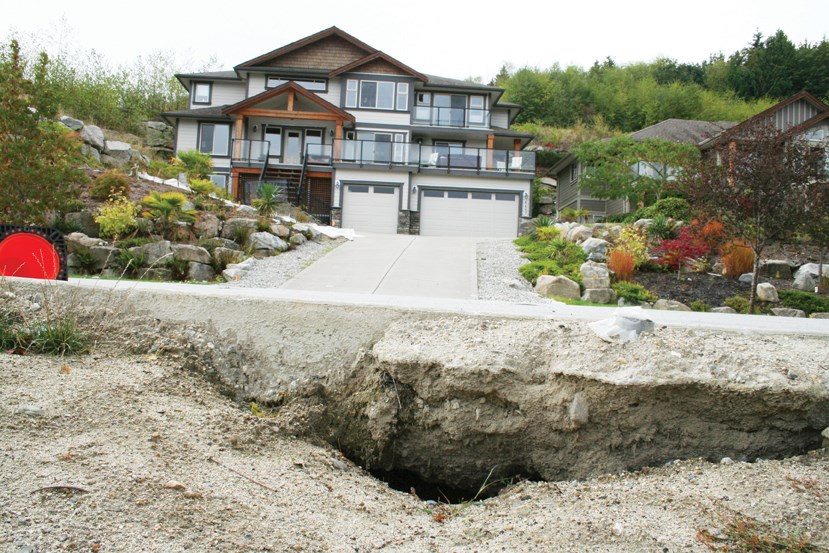The District of Sechelt is getting a second opinion on a geotechnical report that suggests it will take more than $9.5 million to fully understand and start to address sinkholes and other soil disturbances in the Seawatch subdivision at the end of Gale Avenue North.
The District retained Thurber Engineering Ltd. in February to conduct a visual assessment of two sinkholes that had appeared in the Seawatch subdivision, which has 28 residential lots.
Thurber’s scope later expanded to include regular field reviews, a desktop study of historical site information and limited geotechnical investigations.
The first sinkhole investigated was on lot 21, owned by Ross and Erin Storey, who have since filed a civil claim naming several defendants including the District of Sechelt, developer of the subdivision Concordia Seawatch Ltd. and company co-owner Ron Davis.
The second sinkhole Thurber investigated was on Lot 9, which is owned by Davis and holds a show home for the property. That sinkhole is situated close to the top of Lot 9 at the roadway and is causing undermining of Gale Avenue North.
“The full lateral extents of the undermining could not be determined due to the presence of utilities and private property, constraining the extents of the drilling investigation,” Thurber’s report stated.
The report noted that the subdivision “has a history of geotechnical issues including slope instability, surface and sub-surface erosion, voids and sinkhole collapse, many of which may be interrelated.”
It also suggested that “the processes which led to the formation of the two recent sinkholes could continue to develop future sinkholes if the cause is not addressed.”
The report found high groundwater gradients and soil migration to be the primary causes of ground instability in the Seawatch subdivision.
The report’s accompanying cost estimates suggested four options to council ranging from simply reacting to issues as they arise to fully closing the subdivision and abandoning the infrastructure.
The costs don’t include private property solutions as the District is responsible only for public areas.
Option one suggests a reactionary approach that does not address the cause of the ongoing failure, for an estimated cost of $1.2 million.
Option two addresses repairs within the public and utility corridors and suggests redirecting ground water, for an estimated cost of $8.5 million. However, it states the viability “is contingent upon the results of a well testing program and feasibility study to implement a suitable groundwater management system.”
Option three is pitched as the most comprehensive option. While similar to option two, it also includes a “site wide geophysical and drilling investigation program across accessible areas of the subdivision,” for an estimated cost of $9.5 million.
There is no specific cost associated with option four, which calls for closure and abandonment of the subdivision.
“This option would need to include costs for infrastructure decommissioning or removal and site restoration. However, these costs are highly variable depending on the state in which the site is to be left,” the report said.
While the report was accepted by council at an in-camera meeting in July, councillors decided during a Sept. 2 regular council meeting to go forward with a peer review of the document by Braun Geotechnical Ltd.
“They have given us a good report – we think it’s pretty solid – but we’re lay people and I don’t want to find out in other circumstances that something was missed or that other professionals don’t agree with it,” Sechelt Mayor Bruce Milne told Coast Reporter.
“As you can probably imagine with the Storeys filing civil suit, others will probably follow, so we’re doing this to ensure that the District of Sechelt is in the best position possible. We don’t want to learn in a court of law six months from now or two years from now that our engineering report was flawed in some way.”
When asked whether the District or the developer would be responsible to pay for fixes that are deemed necessary, Milne said he couldn’t answer that yet.
“We’re still assessing the full situation to ensure we know what fixes are required as opposed to what fixes people think they’d like to see,” he said.
“We want to make sure there’s a comprehensive understanding of the situation so if we do go forward it actually makes a difference in the future, so this situation doesn’t arise in two years or five years or 10 years from now. So I can’t really answer the details of who will pay for those things.”



